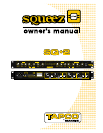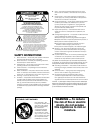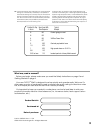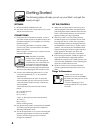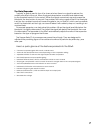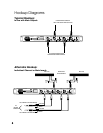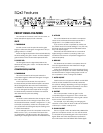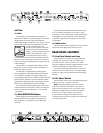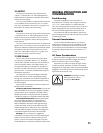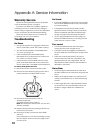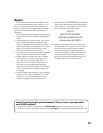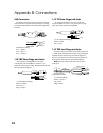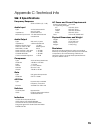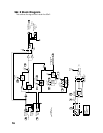
6
Introduction
Thank you for choosing a TAPCO
®
Squeez™ dynamics processor
by Mackie
®
. The TAPCO product line hails back to the days of TAPCO
Corporation, Greg Mackie’s fi rst company. TAPCO revolutionized
the audio industry back in 1969 with the very fi rst 6-channel mixer
specifi cally designed for keyboards and rock ‘N’ roll PA.
In essence, TAPCO redefi ned the price performance ratio and made
high-quality professional audio mixers accessible to virtually anyone.
Today, TAPCO is reborn with the same ideals and is backed by the
world-class engineering and manufacturing horsepower of Mackie. The
TAPCO SQ•2 is the fi rst compressor/limiter/gate processor in the TAPCO
by Mackie
®
family.
About Dynamic Processing
The human ear has an incredible dynamic range (the difference between the softest
and the loudest sounds) and can detect anything from the sound of a butterfl y sneeze
(0 dB SPL, the threshold of hearing) to the sound of the space shuttle taking off (140 dB
SPL, very painful without hearing protection). Audio electronics would like to be able to
duplicate this dynamic range, but current technology falls somewhat short.
Audio electronics introduces another limitation to dynamic range: noise. Even the best
designed audio circuits produce noise due to the physics of electrons moving through
conductors and resistors. It’s called thermal noise, and produces that low level hiss you hear
when you turn the volume controls all the way up on a mixer or on your stereo system at
home.
An experienced sound engineer knows that the louder the mix, the less perceptible the
noise fl oor, because the louder sounds mask the noise. However, mixing at loud levels brings
the signal closer to the point of clipping, where the signal can go no larger. Ideally, you
would like to provide 10 to 20 dB of headroom between the nominal operating level and
the clipping point, to provide a cushion for transient peaks (bass drum beats and cymbal
crashes, for example) to get through without clipping. But then the soft passages may
become too quiet and the noise fl oor becomes a factor. Enter dynamic processing.
The Compressor/Limiter
Wouldn’t it be nice if you could have a hand on the faders and be able to quickly
reduce the volume on the bass drum and cymbals every time they approached clipping,
then quickly return them to their normal levels? A compressor does exactly that. Set the
threshold control to the point where you want the signal to stop getting any louder, and
set the ratio control to regulate the amount of attenuation applied to the signal when it
goes above the threshold. When the ratio control is turned all the way up, it becomes a
limiter and the signal stops getting any louder when it reaches the threshold. The attack
and release controls are used to control how fast the compressor kicks in when the signal
crosses the threshold and how fast it stops acting on the signal when it drops below the
threshold. You can experiment with these controls to get the most natural sound, or simply
push in the AUTO button and the SQ•2 automatically adjusts the attack and release
according to the dynamics of the signal.
TAPCO version of Greg
TAPCO van (a.k.a. micro bus)



